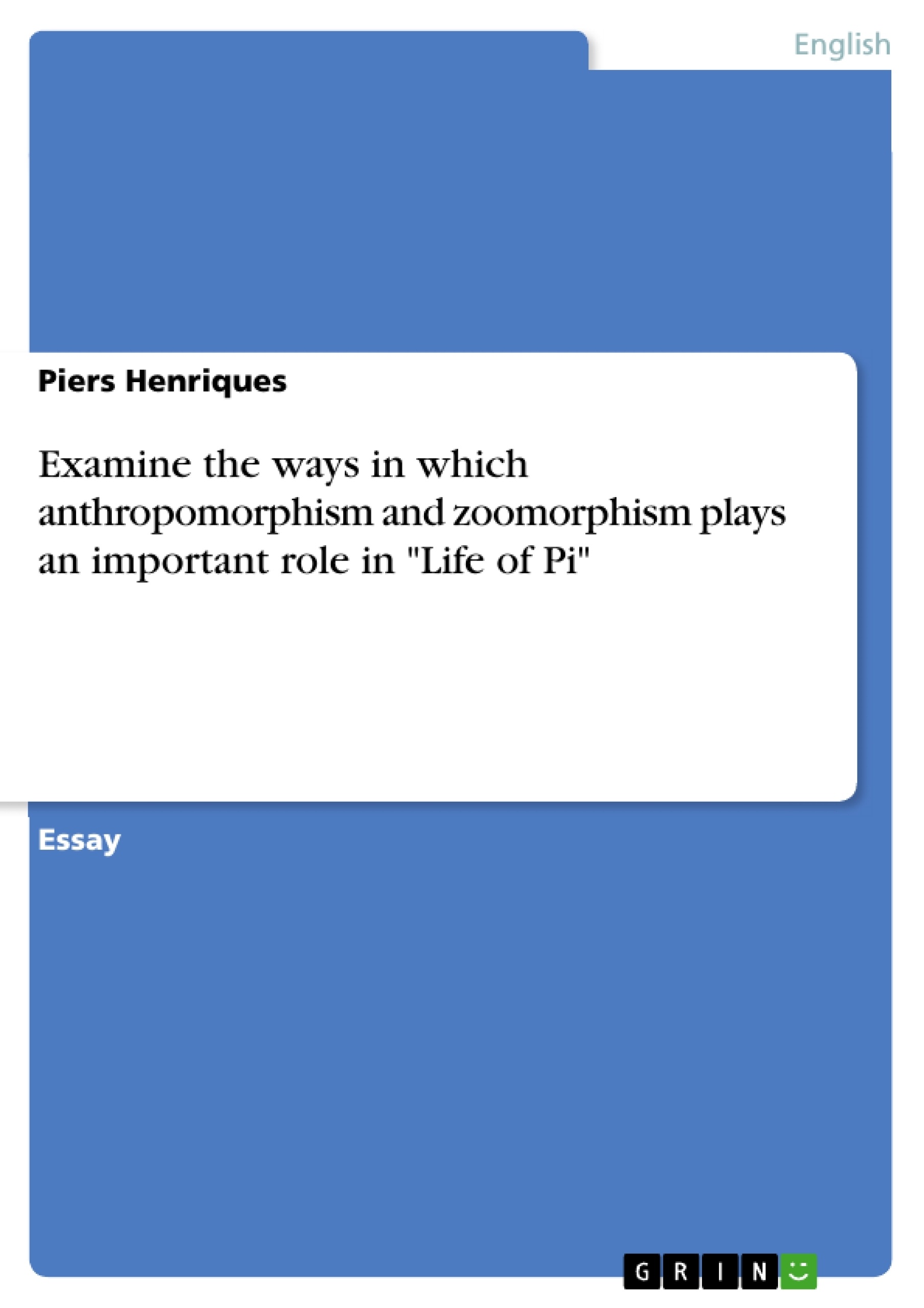Yann Martel’s novel, Life of Pi, follows the story of a boy known as Pi through a journey in which he is subjected whilst stuck on the Pacific Ocean. This paper will analyse the use of literary devices anthropomorphism and zoomorphism, and ask what affect these devices induce on the reader and text.
Examine the ways in which anthropomorphism and zoomorphism plays an important role in Life of Pi
Yann Martel’s novel, Life of Pi, follows the story of a boy known as Pi through a journey in which he is subjected whilst stuck on the Pacific Ocean. This paper will analyse the use of literary devices anthropomorphism and zoomorphism, and ask what affect these devices induce on the reader and text.
Anthropomorphism is a term specifically used to attribute human characteristics to something that is not. When used to characterise animals, its common use is in children’s books to tend to their illimitable imagination. The association of character archetypes within animal forms are then engrained early on, and are powerful literary tools. In Yann Martel’s Life of Pi this technique is employed in a way in which the reader is asked to suspend their disbelief, in order believe a fantastical yet plausible story. The lead protagonist, Pi, in the early stages of the novel identifies anthropomorphism, as well as zoomorphism: which he says is “when an animal takes a human being, or another animal, to be one of their own kind.” The identification of which, early on, signposts a theme of blurring distinctions between differing species, and how the “measure of madness” which “moves life in strange but saving ways” can instinctively tie them together to coexist.
The novel plays out in three parts. In the first, Pi’s character is introduced by initial conversations with a fictional author and Pi. When the journalist describes their relationship in a succinct, journalistic lexis, Pi is found to have resolved his life, but the fictional author notes that “after all these years, Richard Parker is still on his mind”. These observations offer a unique multi-dimensionality to Pi’s character, and distinguishes between reality and “the story”, liable to conjecture. In the second part, “the story” is told by Pi, exclusively. Thirdly, Pi’s direct dialogue ends, and the fictional author uses “verbatim transcriptions” from an interview between Pi and two men from the “Japanese Ministry of Transport”. Pi recounts the story told in part two, and, reluctantly, a story in which all the characters from the first story are human, suggesting the former story was a bold embellishment. Martel’s use of narrative devices and alternate perspectives sets the story firmly in reality, and gives the magical realism rooting in a solid framing structure, imbuing both stories credence.
In the beginning of the novel, the reader is associated with a, perhaps egocentric, intelligent, adolescent boy who names himself by a pseudonym, Pi. He is raised in the surroundings of his father’s zoo and describes waking to “a pride of Lions”, and, in an instance of watching a tiger eating a goat, is assimilated to the fierce nature of wildlife, early on. In this part of the novel also, Pi develops a personal pantheism by worshipping from three distinctly differing religions: Christianity, Hinduism and Islam. In a metaphor, explaining this to his mother, he rhetorically asks: “if there is only one nation in the sky, shouldn’t all passports be valid for it?” Conjunctively, he harbours an interest in his zoological surroundings and has a good relationship with his “favourite” science teacher, Mr Kumar. Mr Kumar is a staunch atheist who proclaims: “religion is darkness”. Curiously, this doesn’t appear to bother Pi, and following this, he states, “it is not atheists that get stuck in my craw, but agnostics”.
Therefore, he identifies that a “choice” between alternating stories needs to be made, and alludes to the forthcoming saga. His interest in zoology and science, as well as his theological belief structure, is what gives Pi’s extraordinary story plausibility. This allows Martel to employ anthropomorphism, and zoomorphism, within a metamorphosis of human characters believably, and test readers’ capacity for faith: do they prefer the “better story” or “dry, yeastless factuality”. Anthropomorphism, and zoomorphism, then become a religiously, and scientifically, symbolic dressing on which Pi turns his story of intense trauma into a bearable, allegoric fable.
Pi tells the reader, in the first chapter, that he is “not one given to projecting human traits onto animals”, but admits in later chapters that he had “anthropomorphised the animals [in his father’s zoo] till they spoke fluent English”. He declares that the most dangerous species of all is “animalus anthropomophicus”, animals seen through man’s eyes. He suggests that this is because man can’t help but “look at an animal and see a mirror”. So when animals elicit human senses such as “devoted, merry” or “bloodthirsty, depraved”, one forgets that although emoting senses, they are not necessarily reflective of animals’ states. This, Pi believes, creates disproportionate senses of comfort, or aggression, in response to a given interaction, putting both animal and human in danger.
[...]
- Citar trabajo
- Piers Henriques (Autor), 2011, Examine the ways in which anthropomorphism and zoomorphism plays an important role in "Life of Pi", Múnich, GRIN Verlag, https://www.grin.com/document/169733
-

-

-

-
¡Carge sus propios textos! Gane dinero y un iPhone X. -

-
¡Carge sus propios textos! Gane dinero y un iPhone X. -

-
¡Carge sus propios textos! Gane dinero y un iPhone X. -

-
¡Carge sus propios textos! Gane dinero y un iPhone X. -

-
¡Carge sus propios textos! Gane dinero y un iPhone X.

